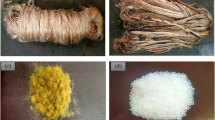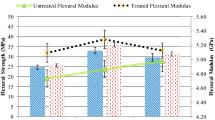Abstract
Due to environmental awareness and depletion of petroleum oil, bioplastics and their composites are one of the most researchable topics throughout the world. Polymers that are produced from renewable sources are expected to be the best alternative to replace conventional polymers. The bottles neck of these bioplastics is its cost which limits its application in certain purposes. Bioplastics filled or reinforced with natural fibers can reduce cost and improve properties, like stiffness, strength and toughness of biocomposites. Impact strength and fracture toughness are the main demerits of short fiber-filled biocomposite. On the other hand, when nanoclay, having a very high aspect ratio, is mixed with bioplastics it may significantly affect the thermal and mechanical properties of the final composites. A composite may also suffer dispersion inefficiency, which is considered the key factor to improve the properties. The aim of this paper was to hybridize nanoclay and short kenaf fiber in polylactic acid (PLA) by double extrusion method and followed by mechanical, thermal and morphological characterizations. Mechanical properties showed improvement with nanoclay, specifically the impact strength increased more than 50 % compared with unreinforced PLA. A double extruded composite showed 3–10 % better tensile and flexural properties than the single extruded composite. Similarly, addition of nanoclay increased decomposition and melting temperatures (T m) from 198 to 225 °C and 152 to 155 °C, respectively. Crystallization temperature (T c), however, dropped with nanoclay from 116 to 106 °C and storage modulus (E’) increased by about 1 GPa. These findings were also supported by scanning electron micrograph (SEM) and transmission electron micrograph (TEM) where in double extruded composite a better dispersion of nanoclay was observed. By employing X-ray diffraction (XRD) it was found that higher percentage of crystallinity was obtained while Fourier transform infrared (FTIR) displayed new bond formation. The presence of nanoclay enhanced thermal and mechanical properties of the hybrid composite.









Similar content being viewed by others
References
Guo XD, Zhang LJ, Qian Y, Zhou J (2007) Effect of composition on the formation of poly(d, l-lactide) microspheres for drug delivery systems: mesoscale simulations. Chem Eng J 131:195–203
Chen C, Lv G, Pan C, Song M, Wu C, Guo D, Wang X, Chen B, Gu Z (2007) Poly(lactic acid) (PLA) based nanocomposites: a novel way of drug-releasing. Biomed Mater 2:L1–L4
Greiner S, Kadow-Romacker A, Wildermann B, Schwabe Ph, Schmidmaier GJ (2007) Bisphosphonates incorporated in a poly(d, l-lactide) implant coating inhibit osteoclast like cells in vitro. Biomed Mater Res A 83A:1184–1191
Chandra R, Rustgi R (1998) Biodegradable polymers. Prog Polym Sci 23:1273–1335
Bogaert JC, Coszach Ph (2000) Poly(lactic acids): a potential solution to plastic waste dilemma. Macromol Symp 153:287–303
Drumright RE, Gruber PR, Henton DE (2000) Polylactic acid technology. Adv Mater 12:1841–1846
Kale G, Auras R, Singh SP, Narayan R (2007) Biodegradability of polylactide bottles in real and simulated composting conditions. Polym Test 26:1049–1061
Kale G, Kijchavengkul T, Auras R, Rubino M, Selke SE, Singh SP (2007) Compostability of bioplastic packaging materials: an overview. Macromol Biosci 7:255–277
Kale G, Auras R, Singh SP (2007) Comparison of the degradability of poly(lactide) packages in composting and ambient exposure conditions. Packag Technol Sci 20:49–70
Lemmouchi Y, Murariu M, Dos Santos AM, Amass AJ, Schacht E, Dubois P (2009) Plasticization of poly(lactide) with blends of tributyl citrate and low molecular weight poly(d, l-lactide)-b-poly(ethylene glycol) copolymers. Eur Polym J 45:2839–2848
Bordes P, Pollet E, Avérous L (2009) Nano-biocomposites: biodegradable polyester/nanoclay systems. Prog Polym Sci 34:125–155
Hapuarachchi TD, Peijs T (2010) Multiwalled carbon nanotubes and sepiolite nanoclays as flame retardants for polylactide and its natural fibre reinforced composites. Composites Part A 41:954–963
Okubo K, Fujii T, Thostenson ET (2009) Multi-scale hybrid biocomposite: processing and mechanical characterization of bamboo fiber reinforced PLA with microfibrillated cellulose. Composites Part A 40:469–475
Ray D, Rout J (2005) In: Mohanty AK, Misra M, Drzal LT (eds) Natural fibers, biopolymers and biocomposites. CRC Press, USA
Hariharan ABA, Abdul Khalil HPS (2005) Lignocellulose-based hybrid bilayer laminate composite. Part I: studies on tensile and impact behavior of oil palm fiber-glass fiber-reinforced epoxy resin. J Compos Mater 39:663–684
Burgueno R, Quagliata MJ, Mohanty AK, Mehta G, Drzal LT, Misra M (2005) Hybrid biofiber-based composites for structural cellular plates. Composites Part A 36:581–593
Mishra S, Mohanty AK, Drzal LT, Misra M, Parija S, Nayak SK, Tripathy SS (2003) Studies on mechanical performance of biofibre/glass reinforced polyester hybrid composites. Compos Sci Technol 63:1377–1385
Reis PNB, Ferreira JAM, Antunes FV, Costa JDM (2007) Flexural behaviour of hybrid laminated composites. Composites Part A Appl Sci Manuf 38:1612–1620
Morye SS, Wool RP (2005) Mechanical properties of glass/flax hybrid composites based on a novel modified soybean oil matrix material. Polym Compos 26:407–416
Panthapulakkal S, Sain M (2007) Injection-molded short hemp fiber/glass fiber-reinforced polypropylene hybrid composites mechanical, water absorption and thermal properties. J Appl Polym Sci 103:2432–2441
Wambua P, Vangrimde B, Lomov S, Verpoest I (2007) The response of natural fibre composites to ballistic impact by fragment simulating projectiles. Compos Struct 77:232–240
Amin KAM, Badri KH (2007) Palm-based biocomposites hybridized with kaolinite. J Appl Polym Sci 105:2488–2496
Thwe MM, Liao K (2003) Durability of bamboo–glass fiber reinforced polymer matrix hybrid composites. Compos Sci Technol 63:375–387
Fu SY, Xu G, Mai YW (2002) On the elastic modulus of hybrid particle/short fiber/polymer composites. Compos B Eng 33:291–299
Karger-Kocsis J (2000) Reinforced polymer blends. In: Paul DR, Bucknall CB (eds) Polymer blends. Wiley, New York, p 395
John MJ, Thomas S (2008) Biofibres and biocomposites. Carbohydr Polym 71:343–364
Sreekala MS, George J, Kumaran MG, Thomas S (2002) The mechanical performance of hybrid phenol-formaldehyde-based composites reinforced with glass and oil palm fibres. Compos Sci Technol 62:339–353
28. Anuar H, Zuraida A, Kovacs JG, Tabi T (2011) Improvement in tensile and flexural properties of injection moulded poly(lactic acid) – kenaf fibre biocomposite. J Thermoplast Compos Mater Doi:0892705711408984
Chow WS, Lok SK (2009) Thermal properties of poly(lactic acid)/organo-montmorillonite nanocomposites. J Thermal Anal Calorim 95:627–632
Kim JY, Kang SW, Kim SH (2006) Thermotropic liquid crystal polymer reinforced poly(butylene terephthalate) composites to improve heat distortion temperature and mechanical properties. Fiber Polym 7:358–366
Acknowledgments
The authors wish to thank International Islamic University of Malaysia (IIUM) for assistance and supportive grant (EDW A11-148-0939) and eScience Fund (03-01-08-SF0087) for assistance in making this study success.
Author information
Authors and Affiliations
Corresponding author
Rights and permissions
About this article
Cite this article
Kaiser, M.R., Anuar, H.B., Samat, N.B. et al. Effect of processing routes on the mechanical, thermal and morphological properties of PLA-based hybrid biocomposite. Iran Polym J 22, 123–131 (2013). https://doi.org/10.1007/s13726-012-0112-4
Received:
Accepted:
Published:
Issue Date:
DOI: https://doi.org/10.1007/s13726-012-0112-4




